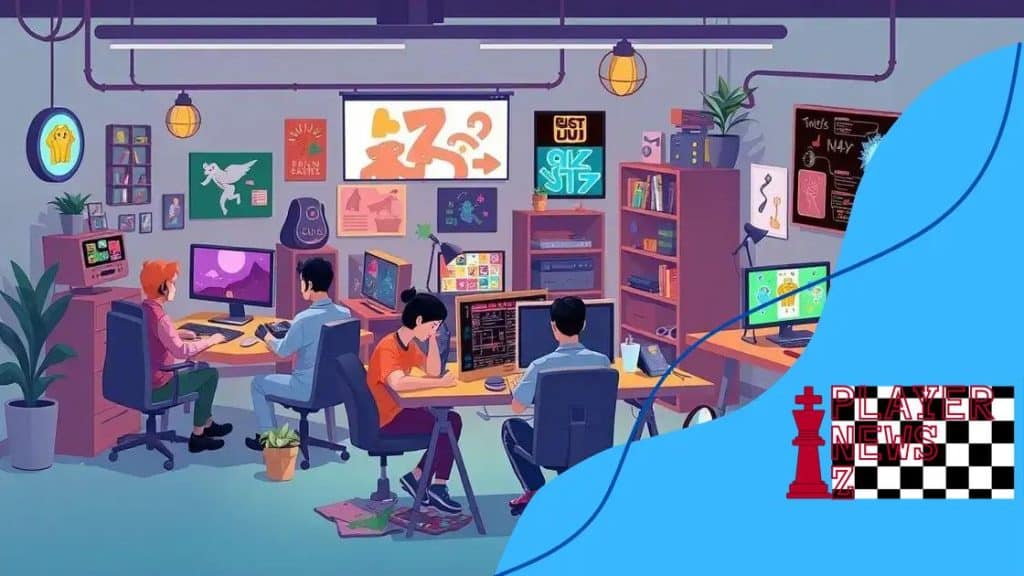The growth of indie games in mainstream markets

The growth of indie games in mainstream markets has led to innovative storytelling, diverse gameplay experiences, and increased visibility for smaller developers, reshaping how gamers engage with new titles.
The growth of indie games in mainstream markets has opened new doors for creativity and innovation in the gaming world. Ever thought about how these small games capture our hearts and minds? Let’s dive into their fascinating rise.
What defines indie games?
When we talk about indie games, it’s essential to understand what sets them apart from more traditional games. These games are typically developed by individuals or small teams without significant financial backing from large studios. This independence allows for greater creative freedom and innovation.
The essence of indie games is their focus on unique gameplay experiences, storytelling, and artistic expression. Unlike mainstream games that often adhere to formulas aimed at maximizing sales, indie games can take risks and explore unconventional themes.
Key Characteristics of Indie Games
Indie games often share several defining traits:
- Creative Freedom: Developers can create without corporate restrictions, leading to diverse gameplay styles.
- Innovative Gameplay: Many indie games introduce new mechanics, offering players fresh experiences.
- Artistic Expression: The art style in indie games varies widely, from pixel art to hand-drawn graphics.
- Emotional Storytelling: Indie games often take bold steps in narrative depth, engaging players on a personal level.
The community around indie games is also a vital part of their identity. Gamers often support these titles through platforms like Steam and Kickstarter, enabling developers to bring their visions to life. This encourages unique interactions between creators and the audience, fostering a sense of belonging.
As we look at the ever-evolving landscape of gaming, it’s clear that indie games are shaping the future. Their emphasis on artistic merit and innovation has inspired many mainstream developers to rethink their approaches. So, when diving into the world of gaming, keep an eye on the indie scene—it holds amazing surprises!
The impact of indie games on mainstream gaming
The impact of indie games on mainstream gaming has been profound and transformative. Over the past decade, we’ve seen how these small-scale titles have influenced major studios and changed player expectations. Indie games encourage innovation, pushing mainstream developers to think outside the box.
One of the most significant shifts is the emphasis on storytelling and character development. Mainstream games are increasingly adopting unique narratives, inspired by successful indie titles. Players now seek deeper emotional experiences, driving publishers to invest in more intricate storytelling.
Influence on Game Design
Indie games have also impacted game design philosophies:
- Experimentation: Many indie developers experiment with gameplay mechanics, leading to new genres and styles.
- Accessibility: Indie games often focus on accessibility, making games available to a broader audience.
- Artistic Values: They prioritize artistic expression, encouraging mainstream games to embrace unique art styles.
- More Diverse Experiences: Indie titles explore themes and concepts that larger studios might avoid.
This cultural exchange has led to an environment where creativity flourishes. As mainstream games start to incorporate ideas from indie titles, we see the rise of unique projects. Gamers have started to appreciate the value of originality and risks taken by indie developers.
Moreover, the accessibility of platforms like Steam and consoles has allowed indie games to reach wider audiences. Gamers around the world can discover and enjoy these unique creations. This growth has encouraged big studios to reassess their product lines, leading to a win-win for everyone involved, including players.
Successful indie games that broke through

Many successful indie games have managed to break through the clutter and gain critical acclaim and commercial success. These games show the potential of small developers to create experiences that resonate with players worldwide. Each of these unique titles has its own story and charm that contributed to its popularity.
One standout title is Celeste, a platformer that combines tight gameplay mechanics with a heartfelt narrative about overcoming personal challenges. Players embark on a journey to climb a mountain, facing various obstacles that reflect emotional struggles. This combination of gameplay and story has touched the hearts of many.
Notable Indie Games
Here are some other notable indie games that have made significant impacts:
- Hollow Knight: An action-adventure game set in a beautifully hand-drawn world filled with intriguing lore and challenging gameplay.
- Stardew Valley: A farming simulation that captured the attention of gamers looking for relaxation and creativity, allowing players to build their dream farm.
- Undertale: A role-playing game that plays with traditional mechanics and offers players meaningful choices that affect the story outcome.
- Dead Cells: A rogue-lite, metroidvania-inspired action game known for its smooth controls and ever-changing levels.
The impact of these games extends beyond just commercial success; they have also inspired a new generation of developers to pursue their visions. By proving that small teams can create rich, engaging experiences, successful indie games encourage creativity in the industry. Their stories reveal that passion drives innovation and that audiences are eager for unique experiences outside the mainstream.
As the gaming landscape continues to evolve, the contributions of indie games remain vital. They push boundaries, challenge norms, and redefine what games can be. Staying tuned to the indie scene is essential for anyone who loves gaming, as it frequently unveils new gems worth exploring.
How platforms support indie developers
Platforms play a crucial role in supporting indie developers, providing them the tools and exposure needed to succeed. These platforms help small teams bring their games to a global audience, drastically changing the landscape of game development.
One of the main ways that platforms assist indie developers is through distribution. Services like Steam provide a space where indie games can thrive alongside larger titles. This visibility helps developers reach gamers who might not otherwise find their work.
Essential Support Features
Various platforms offer features that empower indie developers, such as:
- Publishing Tools: Platforms often include easy-to-use publishing tools that allow developers to upload and manage their games with minimal technical barriers.
- Funding Opportunities: Many platforms have funding programs or partnerships that support indie game development through grants or sponsorships.
- Community Engagement: Platforms provide forums and community tools that allow developers to connect with players, gather feedback, and create a loyal fan base.
- Marketing Support: Platforms often run promotions or spotlight indie games, helping them gain visibility in a crowded market.
Additionally, social media and crowdfunding sites like Kickstarter have also become vital resources. They allow developers not just to gain funding but also to build an audience before their game is even launched. This ability to engage early supporters can be crucial for an indie game’s success.
Overall, the support from platforms enables indie developers to navigate the complex world of game development. By providing essential resources and exposure, these platforms help foster a vibrant indie gaming community, encouraging new and innovative ideas.
Future trends in indie gaming
The world of indie gaming is ever-evolving, and future trends will continue to reshape the industry. With technological advancements and shifting player expectations, indie developers are poised to explore new horizons in game design and distribution.
One significant trend is the rise of virtual reality (VR) and augmented reality (AR). As these technologies become more accessible, indie developers will create immersive experiences that were once only possible for larger studios. This shift will allow players to engage with stories and gameplay in ways that feel personal and interactive.
Key Future Trends
Several trends are emerging in the indie gaming landscape:
- Cross-platform play: More indie games will support cross-platform multiplayer, enabling friends to play together regardless of their device.
- Focus on social interaction: Indie games will increasingly emphasize social experiences, fostering communities around gameplay.
- Diverse storytelling: Expect unique narratives that reflect a variety of cultural backgrounds and personal experiences.
- Environmental awareness: Developers are more likely to incorporate themes of sustainability and environmental issues into their games.
Moreover, the growth of streaming platforms can change how indie games are marketed. Developers can showcase their games on platforms like Twitch, creating real-time engagement with potential players. This approach can build community excitement even before a game is released, allowing for organic growth through community interest.
Lastly, the use of AI and machine learning in game development will likely increase. Indie developers can leverage these technologies to create smarter games that adapt to player behavior, providing a tailored experience. This innovation could set indie games apart, offering unique gameplay mechanics that engage players in new ways.
FAQ – Frequently Asked Questions about Indie Gaming
What defines an indie game?
An indie game is typically developed by small teams without significant financial support from large publishers, allowing for creative freedom and unique gameplay experiences.
How do indie games impact mainstream gaming?
Indie games often introduce innovative ideas and compelling stories, influencing larger studios to rethink their designs and gameplay mechanics.
What platforms support indie developers?
Platforms like Steam, Epic Games Store, and crowdfunding sites like Kickstarter provide vital resources for distribution, funding, and community engagement for indie developers.
What are some future trends in indie gaming?
Future trends include the rise of virtual reality experiences, an emphasis on social gaming, diverse storytelling, and the use of AI in game development.





